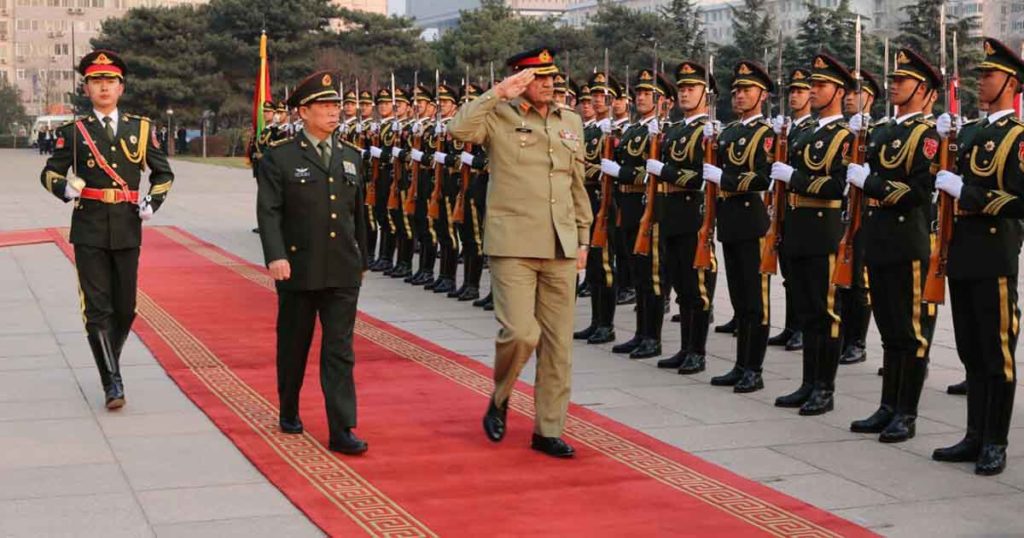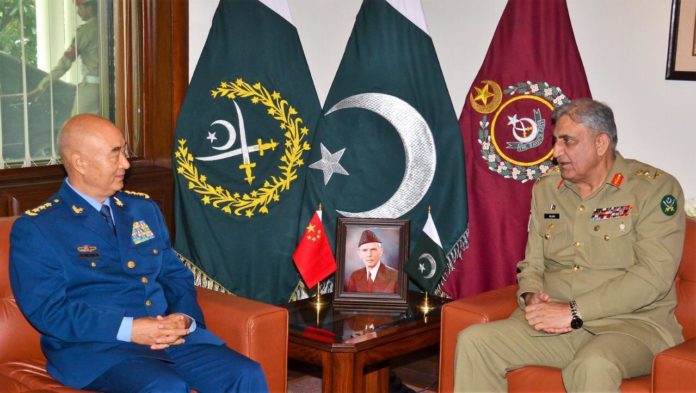Pakistan is currently passing through extraordinary times. Military ties between the two strategic partners, Pakistan and China are on the rise. Both countries are extending military cooperation in diversified fields i.e. human resource management, training, joint military and air force exercise, infrastructure, joint ventures and transfer of technology.
Joint military/air force exercises provide essential training for all participating countries. They are the best means, short of war, for testing armed forces’ capabilities to perform their missions effectively. Most recently the air forces of China and Pakistan began joint exercise Shaheen-VIII’ in northwest China which has now successfully concluded. The annual joint training is the eighth of its kind between the two countries since it was first launched in March 2001.
Shaheen-VIII joint air force exercise was conducted very close to real-combat environment. The air forces of China and Pakistan carried out realistic operations very close to the real-combat environment with the best equipment aimed at enhancing their combat capability. The joint training plays an important role in enhancing both sides’ combat capability and helping them learn from each other through confrontation.
Principally, the joint training does not target any third party and aims to improve training standards of the two air forces through mutual learning. It is hoped that this joint training will help enhance close relations between the two countries in general and develop a mechanism for interoperability of both air forces in particular. The exercise will enhance the capability of participating multinational combined forces to deal with security threats and safeguard regional peace and stability.

Highlights of Shaheen- VIII
A Joint Air Force exercise has the technology orientation which is the engagement of air force resources in training for various real operations, either exploring the effects of warfare or testing strategies without actual combat. The prime objective of Shaheen-VIII exercise was to ensure the combat readiness of deployable forces and ensures the security of our nations.
Chinese and Pakistani air forces wrapped up the half-month-long Shaheen VIII joint exercises in northwestern China, during which systematic mock battles were conducted for the first time. Multiple types of warplanes, surface-to-air missiles and radar installations from the two air forces took part in the mock battles. The red team was from China’s air force and the blue team was a combination of Chinese and Pakistani troops.
Mock Battles
According to international defense manual, mock combat involves the execution of combative actions without intent to harm. Participants can engage in such sparring for ritual, training, recreational or performance reasons. The nature of mock combat can vary from realistic to symbolic. Mock combat can be classified into choreographed and un-choreographed forms
During recently concluded joint exercise of Pakistan Air Force and China Air force, about 50 warplanes, including fighter jets and early warning aircraft took part in the mock battles consisting of seizing air superiority and ground attack. It marked an unprecedented joint exercise between China and a foreign country with the most number of personnel, types of weapons and combat units involved. During the exercises, pilots from both countries also boarded each other’s warplanes and discussed combat techniques. Chinese warplanes including J-10, J-11, J-16, Su-30 fighter jets, JH-7 fighter bombers and KJ-500 early warning aircraft participated in the exercises.
The Shaheen series joint exercises started as a one-on-one dogfight, but now it has evolved into systematic mock battles featuring more warplanes, multiple military branches which include ground forces that deploy missiles and electronic countermeasures. It is hoped that it will enhance capabilities of mock battles, ground combat, air superiority and other military objectives in the days to com.
Last year, the joint training was held in Pakistan in which the Chinese air force, comprising combat pilots, air defense controllers, and technical ground crew along with fighter jets, bombers and early warning AWACS planes rigorously participated. The joint exercise is conducted each year in both countries on an alternate basis.
Shaheen I was held in March 2001 composed of what both sides acknowledged to be “operational” aerial maneuvers involving the Pakistan Air Force (PAF) and the People’s Liberation Army Air Force (PLAAF), held over a period of a few weeks in March 2011. The exercise represented the first time PLAAF combat aircraft deployed to Pakistan and joined alongside their Pakistani counterparts in operational maneuvers in Pakistani airspace. In addition to “Shaheen 1,” both countries also planned to stage joint ground maneuvers involving the People’s Liberation Army (PLA) and its Pakistani counterpart in Pakistan later in 2011. The exercise also took place against the backdrop of the sixtieth anniversary of the establishment of diplomatic relations between China and Pakistan and the recognition of 2011 by both countries as the “Year of Pakistan-China Friendship”.
The series of joint air forces exercises was designed to foster enhanced joint air capabilities and to underscore the priority both sides place on preserving bilateral military ties, the maneuvers executed during all the Shaheen I-VIII featured combat aircraft from the PAF and PLAAF, as well as technicians and other participants.
Most recently, China ‘s General Xu Qiliang, the vice-chairman of the Central Military Commission (CMC) visited the Pakistan Army’s General Headquarters with a high-level delegation and held a one-on-one meeting with Chief of Army Staff General Qamar Javed. According to the Inter-Services Public Relations, the one-on-one meeting was followed by delegation-level talks between the two sides.
“During the meeting, matters of mutual interest, regional security, avenues to enhance bilateral defence collaboration, and particularly the situation in Indian occupied Jammu and Kashmir (IoJ&K) were discussed,” the ISPR said.

COAS Gen Bajwa appreciated China understanding and support on all important issues particularly Kashmir. The visiting dignitary said China “greatly values its time tested relations with Pakistan and its Army and is looking forward to further solidify this relation”, said an ISPR statement. A memorandum of understanding (MoU) was signed by the two sides for enhancement of defence cooperation and capacity building of Pakistan Army.
Such joint exercises are always used to assess the participating forces. The efficacy of their platforms/ weapons and their effective ranges, signatures etc. are all analyzed and recorded. The professionalism of the personnel is of primary importance since any equipment is only as good as the human behind it. Thus, the response timing, thinking process and work ethos are also noted for developing better interoperability. Additionally, it is necessary to decode the nuances of the tactics in use, while simultaneously guarding against revealing too much of one’s own. Thus, exercises have implications at various levels and signify different meanings to different countries and people alike. For a security strategist, they indicate an evolving strategic congruence or in some case an instrument to reduce mistrust, as a confidence-building measure between adversarial powers.
Joint Air Force Exercise Shaheen-VIII signifies an opportunity to display professional prowess, capability, level of combat readiness, and actual operationalization mechanism. Pakistan Air Force (PAF) and the People’s Liberation Army Air Force (PLAAF) have achieved all strategic goals during the most recently concluded joint air force exercise which will further enhance their professionalism, war theater tactics, combat planning and readiness.
India has now purchased and deployed Rafale fighter jets near the borders of Pakistan and China. S-400 anti-missiles is another value addition of the Indian armed forces which has disturbed regional military equation which needs to rectified jointly by Pakistan and China through more close military cooperation.




